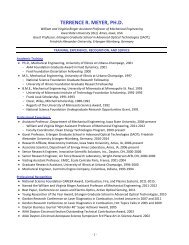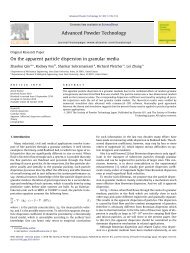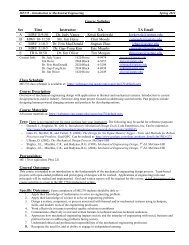Consider-then-Choose Models in Decision-Based Design ...
Consider-then-Choose Models in Decision-Based Design ...
Consider-then-Choose Models in Decision-Based Design ...
Create successful ePaper yourself
Turn your PDF publications into a flip-book with our unique Google optimized e-Paper software.
the general optimal design problem with consider-<strong>then</strong>-choose<br />
models def<strong>in</strong>ed by conjunctive screen<strong>in</strong>g rules. Proofs of all significant<br />
results are given <strong>in</strong> Appendix C.<br />
The General <strong>Design</strong>-and-Pric<strong>in</strong>g Problem<br />
The general consider-<strong>then</strong>-choose optimization problem can<br />
be written as follows:<br />
maximize<br />
with respect to<br />
subject to<br />
π C (X,p)<br />
l j ≤ x j ≤ u j , p j ≥ 0 for all j<br />
c E j (x j ) = 0, c I j(x j ) ≥ 0 for all j<br />
where π C are expected profits normalized by the number of <strong>in</strong>dividuals<br />
I,<br />
π C (X,p) =<br />
J<br />
I<br />
∑ ∑<br />
j=1 i=1<br />
(9)<br />
P C i, j(X,p)(p j − c j (x j )) − cF I , (10)<br />
x j ∈ R N j is a vector of design variables for product j, l j ,u j ∈ R N j<br />
are lower and upper bounds on x j , p j is the price of product<br />
j, c j (x j ) ≥ 0 is a unit cost as a function of design decisions,<br />
c E j : R N j → R ME j are equality constra<strong>in</strong>ts, c I j : RN j → R MI j are <strong>in</strong>equality<br />
constra<strong>in</strong>ts, and c F are (constant) fixed costs for the firm.<br />
Compet<strong>in</strong>g firms and their products are easily <strong>in</strong>corporated but<br />
significantly complicate the notation. As po<strong>in</strong>ted out <strong>in</strong> Section<br />
3, the primary difficulty with Eqn. (9) is that ˆπ C is not necessarily<br />
cont<strong>in</strong>uous, much less smooth, when Pi, C j is def<strong>in</strong>ed by Eqn.<br />
(2). Standard NLP techniques such as SQP or IP methods typically<br />
require the objective and constra<strong>in</strong>t functions to be twice<br />
cont<strong>in</strong>uously differentiable [35], and thus do not obviously apply<br />
to Eqn. (9).<br />
A Bi-Level Approach<br />
A first attempt to solve Eqn. (9), patterned on the ad hoc<br />
approach used <strong>in</strong> Section 3, is outl<strong>in</strong>ed as follows:<br />
(1) Assume a certa<strong>in</strong> collection of consideration sets: that is,<br />
<strong>in</strong>dividual i considers products j i,1 , j i,2 ,..., etc, for all i;<br />
(2) Def<strong>in</strong>e a NLP for this collection by add<strong>in</strong>g constra<strong>in</strong>ts represent<strong>in</strong>g<br />
the screen<strong>in</strong>g rule satisfaction and violation necessary<br />
to generate these exact considerations;<br />
(3) F<strong>in</strong>d the optimal collection of consideration sets by solv<strong>in</strong>g<br />
the result<strong>in</strong>g NLPs over all feasible consideration patterns.<br />
For example, <strong>in</strong> Section 3 the s<strong>in</strong>gle vehicle could be considered<br />
or not. If the vehicle was not considered, profits were (trivially)<br />
zero, which was easily seen to be less than the considerationconstra<strong>in</strong>ed<br />
optimal profits.<br />
This approach can be formalized for the general case as follows.<br />
Let γ ∈ {0,1} IJ , and def<strong>in</strong>e<br />
¯P i, C γ i, j e u i(x j ,p j )<br />
j(γ,X,p) =<br />
1 + ∑ J k=1 γ i,ke u i(x k ,p k )<br />
(11)<br />
The quantity γ i, j expresses whether <strong>in</strong>dividual i considers product<br />
j (γ i, j = 1) or not (γ i, j = 0). Thus, γ encodes an assumed<br />
collection of consideration sets. Note that there are IJ such<br />
quantities, and 2 IJ possible values of γ (step 1). To ensure the<br />
products designed and priced are consistent with an assumed<br />
collection of consideration sets, R + 1 constra<strong>in</strong>ts are required<br />
for each <strong>in</strong>dividual and product: s i (x j , p j ) ≤ 0 if γ i, j = 1 and<br />
max r {s i,r (x j , p j )} > 0 if γ i, j = 0 (step 2). The former ensures<br />
that if we assume <strong>in</strong>dividual i considers product j, <strong>then</strong> <strong>in</strong>dividual<br />
i’s screen<strong>in</strong>g rules are each satisfied by the characteristics and<br />
price of product j. The latter ensures that if <strong>in</strong>dividual i does not<br />
consider product j, <strong>then</strong> at least one of <strong>in</strong>dividual i’s screen<strong>in</strong>g<br />
rules is violated by the characteristics and price of product j.<br />
Both of these constra<strong>in</strong>ts are specific to the assumption of conjunctive<br />
screen<strong>in</strong>g rules.<br />
Given an assumed collection of consideration sets γ, optimal<br />
designs and prices consistent with this collection solve<br />
maximize<br />
with respect to<br />
where<br />
subject to<br />
¯π C (γ,X,p) =<br />
¯π C (γ,X,p)<br />
l j ≤ x j ≤ u j , p j ≥ 0 for all j<br />
c E j (x j ) = 0, c I j(x j ) ≥ 0 for all j<br />
{ }<br />
si (x j , p j ) ≤ 0 if γ i, j = 1<br />
∀i, j<br />
max{s i,r (x j , p j )} > 0 if γ i, j = 0<br />
r<br />
(12)<br />
J<br />
∑<br />
j=1<br />
( )<br />
I<br />
∑<br />
¯P i, C j(γ,X,p) (p j − c j (x j )) − cF<br />
i=1<br />
I .<br />
The constra<strong>in</strong>t max r {s i,r (x j , p j )} > 0 cannot be implemented <strong>in</strong><br />
a conventional NLP sett<strong>in</strong>g. Some form of relaxation, such as<br />
max m {s i,r (x j , p j )} ≥ ε for some ε ≥ 0, is required to implement<br />
the strict <strong>in</strong>equality with exist<strong>in</strong>g NLP techniques. When M > 1,<br />
the non-smoothness associated with the max operator will also<br />
require special treatment.<br />
If the optimal value ¯π C,∗ (γ) of Eqn. (12) can be computed<br />
with standard NLP techniques, this value can be used as the objective<br />
for an upper-level discrete optimization problem<br />
maximize ¯π C,∗ (γ)<br />
with respect to γ ∈ {0,1} IJ (13)<br />
6 Copyright c○ 2012 by ASME
















